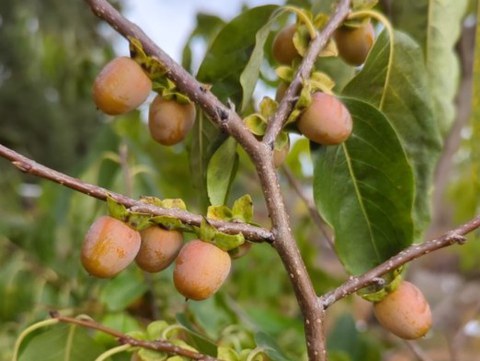Nov 03, 2025
Our plant of the week: The Seven Sons of Heaven shrub

Not a typical early bloomer at first glance: the skunk cabbage surprises with exciting flower biology and is currently blooming in the North American region
The date-plum Diospyros lotus L.
Our plant of the week is a fruit tree that is relatively unknown in this country. The date-plum Diospyros lotus L. colonizes temperate regions from Turkey to Korea.
The female trees of this dioecious species currently bear orange, frosted, sweet-tasting berries about the size of a grape. These are also produced without a male pollination partner (parthenocarpy). Fully ripe and dried fruits can be enjoyed without any worries. Fresh fruit that is not yet fully ripe contains water-soluble tannins, which sometimes leave a furry, astringent mouthfeel.
The fruit contains many valuable secondary plant substances - including carotenoids, minerals, vitamins and fiber. Fruits and seeds are used in various ways in folk medicine. It is not surprising that the taste of lotus plums is reminiscent of persimmons (Diospyros kaki Thunb.): this much larger fruit is a close relative. It has been cultivated in East Asia for over 2000 years and is one of the oldest useful plants there. In Germany, retailers usually offer the seedless and low-tannin persimmon variety 'Sharon'.
In addition to the fruit suppliers, the genus Diospyros, which comprises almost 800 species, also includes some wood-producing species. They gave their name to the ebony plant family, to which the genus belongs. Tropical ebony trees are politically explosive, as they are closely interwoven with colonialism and the transatlantic slave trade.
Visitors to the Botanical Garden Dresden can discover two more species: Diospyros cauliflora Blume and Diospyros whyteana (Hiern) F.White belong to the tropical flora and can be found in Rainforest House I.
(CW 45/25)
Around 10,000 plant species grow in the Botanical Garden of TU Dresden. On this page we regularly present an example of this diversity in more detail. The special features of our scientific plant collection can be seen in many different ways: in amazing adaptations, strange names, interesting uses or even in the extraordinary splendor of their flowers.
You can view previous Plant of the Week articles in the archive.

